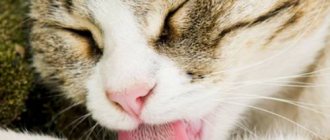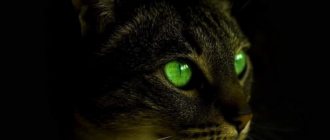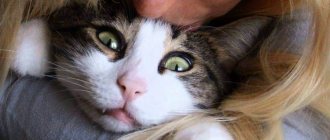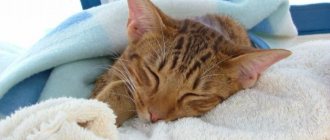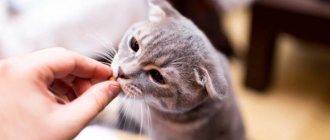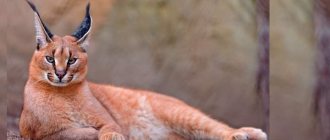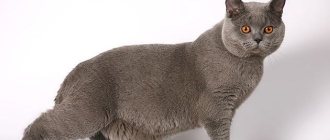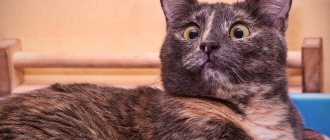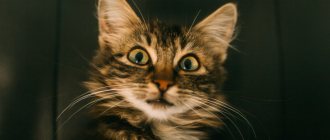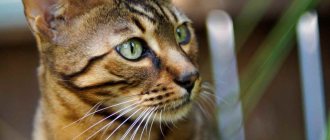How cats appeared in Ancient Egypt
Representatives of felines, according to researchers, first lived in the country in a wild state, like other animals. However, the process of their taming and domestication gradually took place. The common breed of cat is usually called the African wild cat or jungle cat.
It is widely known that the country's economy in ancient times was largely based on irrigation agriculture using the floods of the Nile River. Therefore, one of the main food products of the population was bread cakes. Therefore, the country paid great attention to the safety of the collected grain. Mice and other rodents often ate grain stored in houses. Therefore, residents looked for ways to combat them.
And so they noticed that wild cats catch mice and therefore can help solve the problem of rodent control. This observation prompted the Egyptians to deliberately domesticate cats. For example, they deliberately left fish near their houses so that cats would come to their homes and stay there. Gradually, animals became accustomed to living in and around people’s homes.
Also, one of the problems in the country was poisonous snakes that periodically crawled into people’s homes. Cats also successfully caught snakes. As a result, it turned out that these animals brought different benefits to people. They also took part in hunting other animals. Various images of the era of ancient Egypt have been preserved, where cats are drawn together with people, which shows their prevalence and positive attitude towards them.
Cat Cult: Why did Ancient Egypt extol the feline world?
They have been living next to us for more than 10 thousand years and still remain the most mysterious and enigmatic creatures.
Over the centuries, the cat family has been treated differently. They were credited with supernatural and mystical properties, which often frightened and repelled superstitious citizens, sometimes leading to bloodshed.
But there was a time in history that cats, if they could talk, would boldly call golden - in the literal and figurative sense.
We are talking, of course, about Ancient Egypt, where graceful animals were literally deified. They were immortalized on papyrus and tomb slabs. No expense or precious metals were spared for these purposes.
The image of a cat was closely associated with the concepts of goodness, love, fertility, motherhood and protective power. Young Egyptian women wore amulets with images of cats and prayed that the gods would send them as many children as the kittens depicted on their amulets.
Goddess of the Hearth
Not far from the Nile Delta in the city of Bubastis there was a religious center of the cat goddess Bastet. She was the daughter of the supreme gods Osiris and Isis and occupied a special place in Egyptian mythology.
The goddess of the hearth, who personified sunlight and moonlight, was often depicted as a woman with a cat's head.
Children wore amulets with the image of Bastet so that the goddess would protect them from illness and scorpion stings. In some cases, they even got tattoos with the image of a cat.
But Bastet was not the only goddess in cat form. In the ancient Egyptian Book of the Dead you can find an image of the Great Matu - a light cat who saves people from the serpent Apophis, personifying chaos and evil.
Mummification
Ancient Egyptian cats resembled modern representatives of the Abyssinian breed. They were medium in size, thin, and reddish in color. Today we know about this thanks to cat mummies that archaeologists have found.
The death of a cat was a real tragedy for any Egyptian family. Mourning for a deceased animal lasted about 70 days, and during this time family members shaved their heads and eyebrows as a sign of loss.
Dead animals were wrapped in linen, anointed with fragrant oils and embalmed. In order for pets to “feel good” in the afterlife, toys that they loved to play with during life were placed in their graves.
The mummy was placed in a limestone or wooden sarcophagus, sometimes decorated with gold if the animal lived in the house of a rich man.
Passion for cats
The cult of the cat once played a cruel joke on the Egyptians. The Persian king Cambyses II, aware of the sacred status of the animal, used a forbidden technique during the siege of the border city of Pelusium in 525 BC. e.
The Persian army, according to the stories of Greek historians, could not capture the fortified city, and resorted to cunning. Cambyses ordered each soldier to carry a cat as a human shield.
Pharaoh Psammetichus III could not give the order to attack, because innocent cats could suffer from spears and arrows. The Egyptians surrendered without a fight, and the Persian king Cambyses founded the 27th Dynasty, conquering Egypt.
Commodity-cat relations
On the banks of the Nile, cats were domesticated a thousand years before they spread to other countries. The Egyptians themselves did their best to prevent the cats from being exported, because this meant that the animals were taken away from the pharaoh - a crime punishable by death.
Knowing the value of Egyptian cats, Phoenician traders risked their lives to kidnap and sell the animals to other countries. Egyptian travelers, knowing about this unscrupulousness in commercial matters, bought and stole cats if they saw them in foreign lands.
But such an influential and infectious cat cult could not remain on the sidelines for too long. Figurines, amulets and musical instruments depicting cats were found in Toulouse (France), and in Great Britain archaeologists discovered mass graves of cats.
Around 1500 BC domestic cats were brought to India, Burma and China on trading ships, but the cat remained a rare animal until the beginning of our millennium.
Goddess with a cat's head
Among the pagan idols in ancient Egypt was Bastet. She was originally depicted with the head of a lioness, that is, a representative of the felines. When wild cats were tamed, she was depicted with the head of a cat. This happened around 2000 BC - the time when cats were supposedly domesticated. Bastet was considered an expression of fertility and home. Also, the ancient Egyptians made a connection between it and the moon.
It is widespread in ancient Egypt, the city of Bubastis was considered the center of Bastet, and a building was built there for its idols. During excavations of this city, mummified burials of these animals were found. The court of Pharaoh Shoshenq was also located here. Images of cats are found on the tombs of pharaohs and other people of that time.
What did the destruction of cats bring?
In the Middle Ages, many cats died, which immediately led to sad consequences. The destruction of these domestic animals caused a surge in the reproduction of rats, which, in the absence of natural opponents, became a real threat to the population of Europe in the middle of the 14th century. These vile animals carried fleas through which the bubonic plague was transmitted. The epidemic began to massively cover entire cities. According to historians, about 75 million men, women and children died from the plague during that period, which at that time amounted to a third of the population of Europe. Of course, this would not have happened if cats had not been massacred during the Dark Middle Ages.
How did ancient Egyptian cats live?
The attitude towards cats was special. Science indicates that the cat was a sacred animal of ancient Egypt. They tried to provide comfortable conditions for them. They were carefully looked after and fed the best food. If they fell ill, their owners went to special pagan priests in the Bastet buildings and gave a certain amount of food. The cats living in these buildings had their own special servants who fed them, played musical instruments and took care of them in other ways.
If cats died, they were given a special funeral. They were mummified, and the coffin was made as expensive as possible using gold, carvings, and precious stones. The family whose pet died observed mourning and ate little in the days immediately after the pet’s death. If someone killed a cat, it was severely punished with a very large fine or even the death penalty. In these cases, much depended on the social and property status of the owner.
Persecution of cats by the Inquisition
Animal trials were common in medieval Europe. But cats suffered the most at the hands of the Inquisition. And this is not surprising. After all, the cat, leading a nocturnal lifestyle, eyes glowing in the dark, silently walking and unusually physically resilient, seemed to be a creature not from our world, but the creation of the devil himself. And if she had a black color, they were generally considered a disguised witch. Since then, there has been a sign that a black cat crossing your path is a bad omen.
In a word, back in the 13th century, cats were included in the list of heretics persecuted by the Inquisition, and the cries of animals tortured by Christians were perceived by those who tortured them as the cries of the devil himself.
At a time when witch hunts were gaining momentum, not only women accused of witchcraft were subjected to torture and destruction, but also their beloved pets. That is why cats were perceived as messengers of evil spirits.
What does Sergei Yursky's daughter do: she looks very much like him (new photos)
Urgant on why a woman should always be unpredictable (even in marriage)
Novosibirsk scientists have developed a revolutionary replacement for one of the aircraft parts
But what is surprising is that even after the belief in witches passed, these domestic animals were persecuted in Europe for another century. There was a special day when they were allowed to be killed in any quantity.
Cats in modern Egypt
Science notes that if cats were worshiped in ancient Egypt, today the situation in relation to these animals in the country has changed greatly. They are no longer the subject of pagan ideas. At the same time, they are treated well simply as pets. There are a lot of them in the country. And not only in houses, but just on the streets. For example, a fairly large number of them live in hotels, where they are looked after and fed.
On some streets there are so many of them that you have to walk between them very carefully. In Egypt, cats are somewhat different in appearance from the usual ideas about their appearance. They are thinner with longer legs and not as long hair as is usual. This is usually associated with the peculiarities of the local climate. However, there are a lot of cats in the country and they have a familiar appearance, very fluffy. Overall, it seems that these animals feel quite comfortable in the country.
Beliefs, myths and cats
Besides their appearance, cats were also known to be highly valued from a spiritual perspective. For example, many Egyptians believed that if a cat appeared in their dreams, good luck was on the way.
Cats were also associated with many religions during Ancient Egypt. For example, the Cheetah-like goddess Mafdet was one of Egypt's earliest deities. She was worshiped by those who sought protection from poisonous creatures such as snakes, and also because she represented justice.
However, Bastet was the most famous among all the cat goddesses. Bastet, who was half cat and half woman, was known as the guardian of homes and the protector against evil and disease. People worshiped her widely as she was also associated with femininity and fertility. She was very popular and a festival was regularly held in her honor, one of the biggest celebrations in Egypt.
Interestingly, the priests of the temple maintained large nurseries and cemeteries where people buried their mummified cats. Although there were many other feline Egyptian goddesses (such as Mafdet and Sekhmet), Bastet was the only one who represented the domesticated cat.
What does an Egyptian cat look like?
The Egyptian Mau is an elegant, athletic cat with a spotted coat. A scarab-shaped design on the animal’s head is required: a dark letter M above the eyes and a W at ear level. ... Mau's eyes are mobile, large, and green; The coat is shiny, short or medium length.
Interesting materials:
How to calculate the entropy of information? How to calculate the focal length of a lens? How to calculate the carrying capacity of a vehicle? How to calculate the amount of crushed stone per area? How to calculate house tax in St. Petersburg? How to calculate the required amount of linoleum? How to calculate the amount of natural food for a dog? How to calculate the volume of marketable products? How to calculate the fall and slope of a river? How to calculate the gear ratio?
How wild cats turned into domestic cats
For the first time, wild cats allowed themselves to be tamed by African hunters, receiving in return more food and the opportunity to reproduce under normal conditions. This is how the domestic form of this animal appeared, which gradually began to spread throughout the world, thanks to merchant ships and colonial expeditions. Cats charmed both Buddhist monks and Vikings, becoming for them not just pets, but receiving the status of a deity and a symbol of good luck.
The first cat to appear in Japan was presented to the emperor in 999, and very quickly became the national symbol of this country. She was depicted as a doll figurine with her right paw raised. Since it was believed that it brings good luck, such a cat was present in every home in the country.
In Cambodia, the cat was also perceived as a sacred animal, since it was believed that it was the cat that could attract rain to the plantations and ensure a good harvest.
NASA spotted a snake-like exoplanet with its own atmosphere
Using a radio telescope, astronomers looked at the “cosmic jellyfish” for the first time
It turns out that a person is able to answer questions in a dream: new research
But in Vietnam, China and Korea, these animals were perceived somewhat differently: soup was prepared from them, believing that it gave energy to older people.
First appearance of cats
The connection between people and cats can be traced much earlier. Even 9 thousand years before the invention of the wheel and writing, cave paintings were found depicting cats decorated with precious stones and ornaments. And the first traces of these animals were found in ancient settlements located in the territory between modern Israel and Iraq, in an area called the Fertile Crescent. Former nomads created villages where they began to grow wheat, and in order to store grain and other food products, they needed cats that could catch mice.
The miracle fruit turned out to be even more wonderful: scientists learned about new properties of avocado
The greatest comedian of all time: what happened to the 3 sons of Louis de Funes
Israel plans to open soon: the best places to visit in this country

